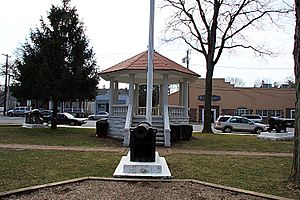Derby-Hall Bandstand facts for kids
The Derby-Hall Bandstand is a special stage in Oyster Bay, New York. It looks just like an old bandstand that used to be here. Important people, like President Theodore Roosevelt, gave speeches from this spot. The first bandstand was taken down in the 1930s. A new one, a replica, was built in 1981. Today, it's a cool place to visit on the Oyster Bay History Walk.
Contents
A Stage for Speeches: The Bandstand's Story
The first Derby-Hall Bandstand was a popular spot for public speaking. President Theodore Roosevelt often used it to talk to people. After many years, the original bandstand was removed in the 1930s. But the community wanted to keep this important gathering place. So, in 1981, a new bandstand was built. It became a fresh platform for speakers and a central meeting spot in the village.
Honoring Important People: Ethel Roosevelt and Leonard Wood Hall
This bandstand was first planned to honor Ethel Roosevelt Derby. She was President Theodore Roosevelt's daughter. Leonard Wood Hall, a local from Oyster Bay, helped organize the project. He was a New York Congressman and a leader of the Republican National Committee in the 1950s. Ethel was his godmother.
Sadly, both Ethel and Leonard passed away before the bandstand was finished. Because of their important roles, the bandstand was dedicated to both of them.
Buildings Around the Bandstand
From the bandstand, you can see two buildings that look quite similar. These are the Town Hall and the U.S. Post Office. Some older residents might remember when the Town Hall East building was once the Lyric Theatre. Many generations of Oyster Bay residents enjoyed movies there.
Cannons with a Past: Stories of War and History
Three old cannons stand around the bandstand, each with its own interesting story.
The USS Maine Cannon
The cannon facing the Town Hall has a special tablet on its base. This tablet was made from metal recovered from the wreckage of the USS Maine. This ship was destroyed in Havana Harbor on February 15, 1898. A terrible explosion killed 266 men. Most historians now believe the explosion was an accident. However, the event caused a lot of tension. This tension helped lead America into the Spanish–American War in 1898.
The cannon itself is a Civil War era Dahlgren gun. It was named after its inventor, Rear Admiral John A. Dahlgren. This gun has a unique "soda bottle" shape. It was made in many sizes and became a standard weapon on Union Navy ships after 1856.
The USS R.R. Cuyler Cannon
The cannon at the bottom of the gazebo stairs is a trophy from the Civil War, from around 1861. It came from the USS R.R. Cuyler. The R.R. Cuyler was a large wooden steamship. The Union Navy used it to block ships from entering Florida's west coast. This 30-pound Parrott gun weighs about 1,592 kilograms (3,510 pounds). The Navy gave it to Oyster Bay. President Theodore Roosevelt himself showed it to the public in 1903.
See also


